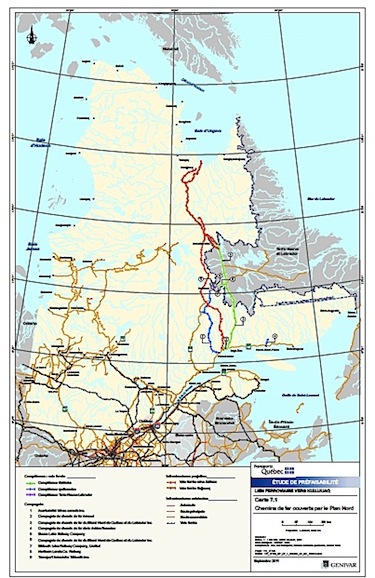Nunavik may be on track for railway
Study pegs cost of railway from Schefferville to Kuujjuaq at $2.5 billion

In this map from Genivar’s study on the feasibility of a rail link from Schefferville to Kuujjuaq, you can see the possible track of the proposed railway in red.
A newly-released study says a rail link between Schefferville and Nunavik is possible — but it won’t come cheap.
The study, which looked at the feasibility of building a roughly 600-kilometre line linking Kuujjuaq to the province’s southern rail network, estimates the project would cost upwards of $2.5 billion and it would take several years to build.
Genivar, a Quebec-based engineering firm, prepared the study, which was presented to Quebec’s national assembly last week.
The rail link would bring obvious benefits to Nunavimmiut, the study notes — it would drive down the cost of goods shipped to the region and bring more tourists to Nunavik.
But the railway’s viability relies heavily on the mining projects under development in the region.
In that sense, the railway project aligns itself closely with Quebec’s Plan Nord, which aims to open up the province’s northern region to resource development.
The Genivar study found the area between Schefferville and Kuujjuaq to be rich in mineral resources, such as uranium, iron, gold, nickel and rare earths.
In fact, the study area includes more than 17,000 mining claims held by 60 different companies — roughly nine per cent of all the claims in Quebec.
Only a handful of projects are at more advanced stages in development, including Adriana Resources’ Lake Otelnuk project.
Lake Otelnuk’s iron ore project, which eyes being in operation by 2016, would benefit directly from the rail link and help dictate the general layout of the rail line.
That layout includes one rail line, with extra passing tracks every 27 km, based on Adriana Resources’ estimated traffic.
The study cited two variants for each end of the railway: at the route’s northern end, the railway could link to a port site at the west bank for the Koksoak river just outside of Kuujjuaq.
The other option is linking the rail line to a port site on the east bank of the Koksoak, which wouldn’t allow direct access to Kuujjuaq.
But the study notes that further studies are needed to determine if port sites along the river, or even downstream at Ungava Bay, are feasible.
At the route’s southern end, the link could remain entirely within Quebec, or take a detour through Newfoundland and Labrador.
The southern track that takes a slight detour through a portion of Labrador (Newfoundland) would run about $60 million more than a route that runs entirely through the province of Quebec, the study notes.
And the location of the southern link could also dictate how the rail link is managed.
If the railway skirts into Labrador, it would be subject to federal law which, unlike Quebec law, requires a railway provide service to a third party.
The study considers both public and private financing models — or a combination of both — for the rail link’s management.
Along the rail link’s northern portion, construction crews would face a number of obstacles including about 400 streams, a handful of small to large rivers and at least 79 km of permafrost.
The report notes that rising temperatures in the region of Nunavik — about 3.5 C from 1990-2007 — could create sinking of the top layer of soil in areas with permafrost.
The actual design of the rail link’s infrastructure will require a more specific analysis of soil and frost conditions along the route, the study says.
As far as competing transportation in the region, maritime traffic is expected to take a hit should a rail link be built to Kuujjuaq, the study found.
Maritime shipping company NEAS estimates that a rail link would mean a decrease of between seven and 10 per cent of their Nunavik-bound business.
The construction of a railroad could also impact the operations of Nunavik’s two major airlines, First Air and Air Inuit.
But the study says both could continue to operate at normal capacity given the airlines’ destinations.
That’s because the study anticipates an overall increase in passenger traffic that a rail link would bring to Nunavik.
The Genivar report was not commissioned by Quebec’s transport department nor by the province’s Plan Nord, but rather by a parliamentary committee who heard from proponents of the rail link during a September 2010 sitting.
The group, which calls their project the TransQuebec Express, gathered 3,842 signatures on a petition in support of the railway link.
But the group’s vision is larger than the study area considered; they want to see a railway that would span 10,000 km, linking Schefferville to Kuujjuaq and then a loop to the north linking several of Nunavik’s communities and possible mining sites along Ungava Bay.
Plan Nord has already committed to study the feasibility of building road links between Schefferville and Kuujjuaq as well as between Radission and Kuujjuaraapik.
Those studies, expected to start in 2012, will compare the benefits of road and rail links, and public consultations are planned in Kuujjuaq for early in 2012.





(0) Comments